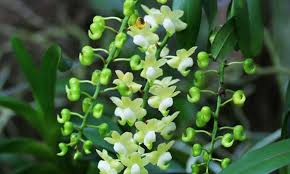
## Introduction
White Egg Orchids, scientifically known as *Dendrobium crumenatum*, are beloved for their strikingly beautiful white flowers and adaptability to various growing conditions. However, even experienced orchid enthusiasts can encounter challenges when growing these exquisite plants. Understanding the common mistakes made in orchid cultivation can lead to better care, healthier plants, and more beautiful blooms. This comprehensive guide will explore the most frequent errors in growing White Egg Orchids and provide practical solutions to overcome them.
—
## 1. Inadequate Light Conditions
### 1.1. Mistake: Insufficient or Excessive Light
One of the most common mistakes in growing White Egg Orchids is providing inadequate or excessive light. Orchids require bright, indirect sunlight to thrive. Too little light can result in weak growth, while too much can scorch the leaves.
### 1.2. Solution: Proper Light Management
– **Location:** Place your orchid near a window with filtered sunlight, or use sheer curtains to diffuse direct sunlight.
– **Monitoring:** Observe your plant for signs of light stress. Yellowing leaves may indicate too much light, while dark green leaves could suggest insufficient light.
– **Adjusting Light Exposure:** If you notice signs of stress, relocate the orchid to a more suitable area or use artificial grow lights to supplement natural light.
—
## 2. Overwatering or Underwatering
### 2.1. Mistake: Incorrect Watering Practices
Watering is crucial for the health of White Egg Orchids, but it can be a double-edged sword. Overwatering can lead to root rot, while underwatering can cause dehydration and stunted growth.
### 2.2. Solution: Develop a Consistent Watering Routine
– **Check Moisture Levels:** Before watering, check the top inch of the growing medium. If it feels dry, it’s time to water.
– **Watering Technique:** Water thoroughly, ensuring excess water drains out of the pot. Avoid letting the orchid sit in standing water.
– **Seasonal Adjustments:** Water more frequently during the growing season (spring and summer) and reduce watering during the dormant period (fall and winter).
—
## 3. Poor Air Circulation
### 3.1. Mistake: Stagnant Air
Good air circulation is essential for White Egg Orchids to prevent fungal diseases and encourage healthy growth. Many growers overlook the importance of airflow in their orchid care routine.
### 3.2. Solution: Improve Airflow
– **Placement:** Avoid overcrowding your orchids. Ensure they have enough space between them for air to circulate.
– **Fans:** Consider using a small fan to promote airflow around your orchids, especially in humid environments.
– **Pruning:** Regularly prune dead or yellow leaves to improve airflow and reduce the risk of disease.
—
## 4. Inappropriate Growing Medium
### 4.1. Mistake: Using the Wrong Medium
The choice of growing medium can significantly impact the health of White Egg Orchids. Using a medium that retains too much moisture or doesn’t provide adequate drainage can lead to root problems.
### 4.2. Solution: Choose the Right Growing Medium
– **Recommended Medium:** Use a well-draining medium specifically designed for orchids, such as a mix of pine bark, perlite, and sphagnum moss.
– **Repotting:** If you suspect your orchid is in the wrong medium, consider repotting it with a fresh mix to promote healthy root growth.
—
## 5. Incorrect Fertilization Practices
### 5.1. Mistake: Over-fertilizing or Under-fertilizing
Fertilization is essential for healthy growth, but too much or too little can harm your White Egg Orchids. Over-fertilization can lead to salt buildup, while under-fertilization can result in nutrient deficiencies.
### 5.2. Solution: Balanced Fertilization Schedule
– **Type of Fertilizer:** Use a balanced orchid fertilizer diluted to half strength during the growing season.
– **Frequency:** Fertilize every 4-6 weeks, reducing or eliminating fertilization during the dormant period.
– **Flush the Medium:** Occasionally flush the growing medium with plain water to remove excess salts and prevent buildup.
—
## 6. Temperature Fluctuations
### 6.1. Mistake: Ignoring Temperature Needs
White Egg Orchids thrive in specific temperature ranges. Significant fluctuations in temperature can stress the plant and affect its growth and flowering.
### 6.2. Solution: Maintain Stable Temperatures
– **Ideal Range:** Aim to keep your orchids in temperatures between 65°F to 85°F (18°C to 29°C) during the day and slightly cooler at night.
– **Location:** Avoid placing your orchids near drafty windows, heating vents, or air conditioning units to prevent temperature extremes.
—
## 7. Neglecting Humidity Requirements
### 7.1. Mistake: Low Humidity Levels
White Egg Orchids thrive in humid environments. Low humidity can lead to dry leaves, poor growth, and increased susceptibility to pests.
### 7.2. Solution: Increase Humidity
– **Humidity Levels:** Aim for humidity levels between 50% and 70% for optimal growth.
– **Humidity Trays:** Use humidity trays filled with water and pebbles beneath your pots to increase moisture in the air around the orchids.
– **Misting:** Lightly mist your orchids with water to raise humidity, especially during dry seasons. However, avoid excessive misting to prevent water from sitting on leaves, which can lead to rot.
—
## 8. Pests and Diseases
### 8.1. Mistake: Ignoring Pest Problems
Pests such as aphids, spider mites, and mealybugs can wreak havoc on White Egg Orchids. Many growers may overlook early signs of infestation until it’s too late.
### 8.2. Solution: Regular Inspection and Treatment
– **Regular Checks:** Frequently inspect your orchids for signs of pests or diseases, including discolored leaves, webbing, or sticky residue.
– **Treatment Options:** If you notice pests, treat them immediately with insecticidal soap, neem oil, or other organic pest control methods.
– **Isolation:** Isolate infested plants to prevent the spread of pests to healthy orchids.
—
## 9. Lack of Pruning
### 9.1. Mistake: Neglecting to Prune
Many growers underestimate the importance of pruning. Failing to prune dead or damaged leaves and stems can hinder the plant’s growth and increase the risk of disease.
### 9.2. Solution: Regular Pruning
– **When to Prune:** Prune your White Egg Orchid after flowering or during the growing season to promote healthy growth.
– **Cutting Techniques:** Use clean, sharp tools to remove dead or yellowing leaves and spent flower spikes. This helps direct the plant’s energy to new growth.
—
## 10. Ignoring Repotting Needs
### 10.1. Mistake: Holding Off on Repotting
Orchids grow best when repotted every 1-2 years. Holding off on repotting can lead to root binding and unhealthy plants.
### 10.2. Solution: Schedule Regular Repotting
– **Signs of Repotting:** Look for signs such as roots growing out of the pot, compressed growing medium, or a decline in plant health.
– **Repotting Process:** Gently remove the orchid from its pot, trim away any dead or rotted roots, and repot it into fresh growing medium.
—
## 11. Not Researching the Specific Needs of White Egg Orchids
### 11.1. Mistake: Generalizing Orchid Care
Each orchid species has unique care requirements. Failing to research the specific needs of White Egg Orchids can lead to improper care.
### 11.2. Solution: Educate Yourself
– **Research:** Take the time to read about the specific needs of White Egg Orchids, including their light, temperature, watering, and fertilization preferences.
– **Join Communities:** Engage with orchid care communities online or locally to gain insights and share experiences with other growers.
—
## Conclusion
Growing White Egg Orchids can be a rewarding experience, but it comes with its challenges. By being aware of common mistakes and implementing the solutions outlined in this guide, you can create a thriving environment for your orchids. With proper care, attention to detail, and a willingness to learn, your White Egg Orchids can flourish and bring beauty to your home or garden. Happy growing!


